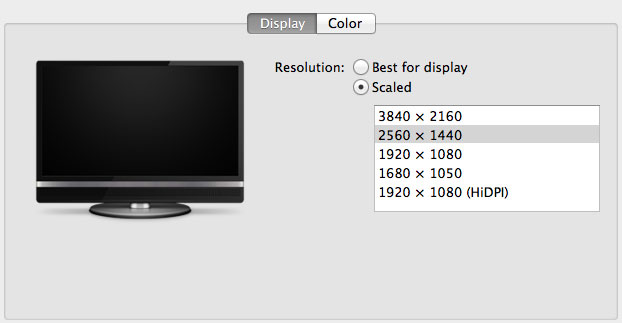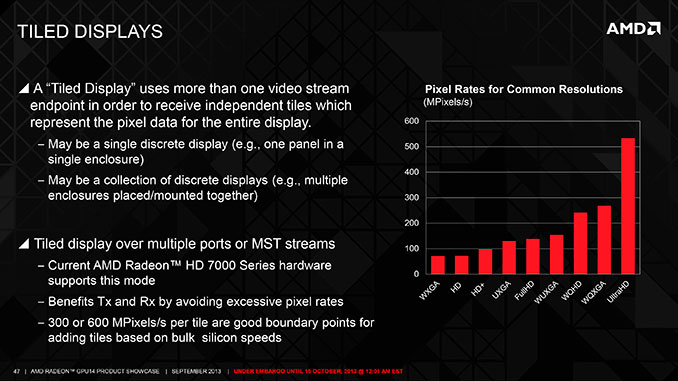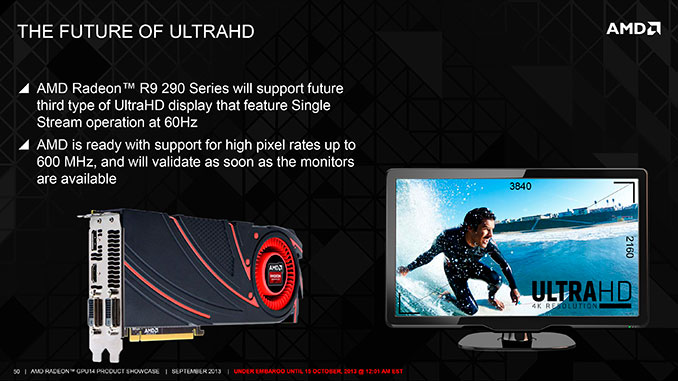The Mac Pro Review (Late 2013)
by Anand Lal Shimpi on December 31, 2013 3:18 PM EST4K Support
A huge part of the Mac Pro revolves around its support for 4K displays. You can connect two 4K displays via Thunderbolt 2/DisplayPort, and the third 4K display over HDMI. Alternatively you can connect up to six 2560 x 1440 displays using the Thunderbolt 2 ports at the back of the machine.
While the 2013 MacBook Pro with Retina Display can presently support outputting to either an 3840 x 2160 or 4096 x 2160 external panel, the maximum supported refresh rate is only 30Hz under OS X (and only 24Hz in the case of a 4096 x 2160 display). That’s acceptable for use as a video preview display, but extremely frustrating for anything else (try watching a mouse cursor animate at 30Hz). Contrary to what Apple’s own support documentation lists, these 4K resolutions at limited refresh rates are supported via both HDMI and Thunderbolt 2/DisplayPort 1.2 on the new rMBPs.
To support 4K at 60Hz, you need to properly enable support for DisplayPort 1.2’s Multi-Stream Transport (MST) feature. Originally conceived as a way of daisy chaining multiple displays together off of a single DP output, the current crop of 4K displays use MST to drive a single display. By sending two tiles, each behaving like a 1920 x 2160 display (one half of 3840 x 2160), you can get around the bandwidth limitations of the current crop of display hardware. Note that it is possible to drive a 4K display at 60Hz using a single DisplayPort 1.2 stream, the limitation today appears to be entirely on the monitor side. The first generation of 4K displays appear to be a bit of a hack. I’m not sure if the Mac Pro’s GPU hardware can drive upcoming 4K single stream panels or not as AMD specifically lists that as a feature of the new Radeon R9 series.
The 4K/MST support requires a software component as well. The GPU driver needs to know how to divide its frame buffer for output to the individual tiles, which can vary between monitors. MST topologies for single-display/4K60 support aren’t standardized unfortunately. Apple handles this by maintaining some sort of a whitelist for various displays they’ve tested. The Sharp PN-K321 that Apple sells alongside the Mac Pro (as well as the ASUS clone of it) ships with 4K60 support configured out of the box. All you need to do is ensure that DisplayPort 1.2 MST is enabled on the display itself (something that appears off by default) and plug it into the Mac Pro. OS X will automatically recognize the display, configure it for 3840 x 2160 at 60Hz and you’re good to go.
The same isn’t true, unfortunately, for other 4K displays on the market. Dell sent along its UltraSharp 24 Ultra HD display (UP2414Q) for this review, and unfortunately that appears to be a display that’s not supported by the Mac Pro/OS X at this point. You can get it working in SST mode at 3840 x 2160 30Hz, but forcing MST results in a 1920 x 2160 display spread across both tiles with a mess of garbled colors.
Update: Apple addressed many of my 4K issues with OS X 10.9.3.
The 4K Experience
For years I used a 30” 2560 x 1600 panel, but when the first wave of 27” 2560 x 1440 displays hit I was instantly hooked. I appreciated the reduction in desktop footprint and didn’t mind horribly the reduction in vertical resolution. I’m a big fan of Apple’s 27” Cinema, Thunderbolt and iMac Displays as they integrate nicely with the Mac (hooray for brightness controls on the keyboard), and I’ve grown to be ok (and maybe even prefer?) the look of the glossy cover glass. Moving to Sharp’s 32” 4K PN-K321 brought back memories of my 30” days. The display is absolutely huge. OS X (and Windows 8.1) running at 3840 x 2160 is incredible, but I find that text, menus and UI elements can be too small. My eyesight isn’t what it used to be and 3840 x 2160 on a 32” panel is just past the borderline of comfortable for me. For editing photos and videos it’s great, but for everything else the ~30% increase in pixel density was just too much.
Apple actually created a solution to this problem with the MacBook Pro’s Retina Display. On a 13 or 15-inch MacBook Pro with Retina Display Apple renders the screen at full panel resolution (e.g. 2880 x 1800), but renders things like text, menus and UI elements at 4x their normal resolution (2x in each dimension). In supported apps, photos and videos are rendered at a 1:1 ratio with pixels on screen. The combination of the two results in a display that’s both incredibly high res and usable. In the case of the 15-inch MacBook Pro, you get the screen real estate (and corresponding text/widget size) of a 1440 x 900 panel, with the exception of any photo/video/other-special content that can treat the display like a full 2880 x 1800 panel.
For those users who still need more screen real estate and don’t mind trading off UI element size, Apple offers scaling modes that render the screen at an even higher resolution and then scale it down to fit the 2880 x 1800 panel. For example you can select a 1920 x 1200 equivalency mode, which gets rendered at 3840 x 2400 with text/menus/UI elements at 4x res and then scaled down to 2880 x 1800. Apple even wrote their own scaling and filtering algorithms to ensure a consistent user experience regardless of what GPU was active at the time (Intel and NVIDIA scaling/filtering algorithms apparently produce slightly different quality output).
I was fully expecting all of this to be available on the Mac Pro when connected to a 32” 4K display. By default, there’s only a single supported scaled resolution: 2560 x 1440. Unfortunately it doesn’t look like Apple is running the same supersampling routines when you pick this resolution, instead you get a 2560 x 1440 desktop scaled up to 3840 x 2160 (rather than a 5120 x 2880 screen scaled down). The result is a bit of a blurry mess.

You can use tools like SwitchResX (or Quartz Debug or the necessary Terminal command) to enable a 1080p HiDPI mode, but then you end up with insanely low point density of around 68 PPI. Unfortunately it doesn’t appear to be possible to define your own HiDPI modes in OS X, you have to rely on those that Apple officially supports. I tried creating a 5120 x 2880 (2560 x 1440 HiDPI) mode but I couldn't get it working under Mavericks. I'm not sure if I was limited by the OS or if Sharp's EDID-specified max resolution of 3840 x 2160 prevented OS X from accepting what I was trying to do.
Apple tends to be very focused on controlling the user experience so it can ensure a good one. Given that Apple hasn’t yet thrown its hat into the 4K display race, it’s not surprising that we don’t have a plethora of HiDPI scaled resolutions available for 3rd party 4K displays.
If Apple decides to stick to its traditional method of scaling resolution in pursuit of a desktop Retina Display I would expect to see a 27” 5120 x 2880 panel, and perhaps a 24” 3840 x 2160 option. The latter already exists in the form of Dell’s UP2414Q but my guess is Apple is waiting on panel readiness to do a 27” version before pulling the trigger.
The rest of the 4K experience under OS X was pretty good. The PN-K321 display seemed far more compatible with the Mac Pro setup than the UP2414Q. Wake from sleep wasn't an issue the vast majority of the time. I did have one situation where I had to disconnect/reconnect the DisplayPort cable after the display wouldn't wake up.












267 Comments
View All Comments
zepi - Wednesday, January 1, 2014 - link
How about virtualization and for example VT-d support with multiple gpu's and thunderbolts etc?Ie. Running windows in a virtual machine with half a dozen cores + another GPU while using rest for the OSX simultaneously?
I'd assume some people would benefit of having both OSX and Windows content creation applications and development environments available to them at the same time. Not to mention gaming in a virtual machine with dedicated GPU instead of virtual machine overhead / incompatibility etc.
japtor - Wednesday, January 1, 2014 - link
This is something I've wondered about too, for a while now really. I'm kinda iffy on this stuff, but last I checked (admittedly quite a while back) OS X wouldn't work as the hypervisor and/or didn't have whatever necessary VT-d support. I've heard of people using some other OS as the hypervisor with OS X and Windows VMs, but then I think you'd be stuck with hard resource allocation in that case (without restarting at least). Fine if you're using both all the time but a waste of resources if you predominantly use one vs the other.horuss - Thursday, January 2, 2014 - link
Anyway, I still would like to see some virtualization benchs. In my case, I can pretty much make it as an ideal home server with external storage while taking advantage of the incredible horse power to run multiple vms for my tests, for development, gaming and everything else!iwod - Wednesday, January 1, 2014 - link
I have been how likely we get a Mac ( Non Pro ) Spec.Nvidia has realize those extra die space wasted for GPGPU wasn't worth it. Afterall their main target are gamers and gaming benchmarks. So they decided for Kepler they have two line, one for GPGPU and one on the mainstream. Unless they change course again I think Maxwell will very likely follow the same route. AMD are little difference since they are betting on their OpenCL Fusion with their APU, therefore GPGPU are critical for them.
That could means Apple diverge their product line with Nvidia on the non Professional Mac like iMac and Macbook Pro ( Urg.. ) while continue using AMD FirePro on the Mac Pro Line.
Last time it was rumoured Intel wasn't so interested in getting a Broadwell out for Desktop, the 14nm die shrink of Haswell. Mostly because Mobile / Notebook CPU has over taken Desktop and will continue to do so. It is much more important to cater for the biggest market. Not to mention die shrink nowadays are much more about Power savings then Performance Improvements. So Intel could milk the Desktop and Server Market while continue to lead in Mobile and try to catch up with 14nm Atom SoC.
If that is true, the rumor of Haswell-Refresh on Desktop could mean Intel is no longer delaying Server Product by a single cycle. They will be doing the same for Desktop as well.
That means there could be a Mac Pro with Haswell-EP along with Mac with a Haswell-Refresh.
And by using Nvidia Gfx instead of AMD Apple dont need to worry about Mac eating into Mac Pro Market. And there could be less cost involve with not using a Pro Gfx card, only have 3 TB display, etc.
words of peace - Wednesday, January 1, 2014 - link
I keep thinking that if the MP is a good seller, maybe Apple could enlarge the unit so it contains a four sided heatsink, this could allow for dual CPU.Olivier_G - Wednesday, January 1, 2014 - link
Hi,I don't understand the comment about the lack of HiDPI mode here?
I would think it's simply the last one down the list, listed as 1920x1080 HiDPI, it does make the screen be perceived as such for apps, yet photos and text render at 4x resolution, which is what we're looking for i believe?
i tried such mode on my iMac out of curiosity and while 1280x720 is a bit ridiculously small it allowed me to confirm it does work since OSX mavericks. So I do expect the same behaviour to use my 4K monitor correctly with mac pro?
Am I wrong?
Gigaplex - Wednesday, January 1, 2014 - link
The article clearly states that it worked at 1920 HiDPI but the lack of higher resolutions in HiDPI mode is the problem.Olivier_G - Wednesday, January 1, 2014 - link
Well no it does not state that at all I read again and he did not mention trying the last option in the selector.LumaForge - Wednesday, January 1, 2014 - link
Anand,Firstly, thank you very much for such a well researched and well thought out piece of analysis - extremely insightful. I've been testing a 6 core and 12 core nMP all week using real-life post-production workflows and your scientific analysis helps explain why I've gotten good and OK results in some situations and not always seen the kinds of real-life improvements I was expecting in others.
Three follow up questions if I may:
1) DaVinci Resolve 10.1 ... have you done any benchmarking on Resolve with 4K files? ... like FCP X 10.1, BMD have optimized Resolve 10.1 to take full advantage of split CPU and GPU architecture but I'm not seeing the same performance gains as with FCP x 10.1 .... wondering if you have any ideas on system optimization or the sweet spot? I'm still waiting for my 8 core to arrive and that may be the machine that really takes advantage of the processor speed versus cores trade-off you identify.
2) Thunderbolt 2 storage options? ... external storage I/O also plays a significant role in overall sustained processing performance especially with 4K workflows ... I posted a short article on Creative Cow SAN section detailing some of my findings (no where as detailed or scientific as your approach I'm afraid) ... be interested to know your recommendations on Tbolt2 storage.
http://forums.creativecow.net/readpost/197/859961
3) IP over Tbolt2 as peer-to-peer networking topology? ... as well as running the nMPs in DAS, NAS and SAN modes I've also been testing IP over Tbolt2 .... only been getting around 500 MB/s sustained throughput between two nMPs ... if you look at the AJA diskwhack tests I posted on Creative Cow you'll see that the READ speeds are very choppy ... looks like a read-ahead caching issue somewhere in the pipeline or lack of 'Jumbo Frames' across the network ... have you played with TCP/IP over Thunderbolt2 yet and come to any conclusions on how to optimize throughput?
Keep up the good work and all the best for 2014.
Cheers,
Neil
modeleste - Wednesday, January 1, 2014 - link
I noticed that the Toshiba 65" 4k TV is about the same price as the Sharp 32" The reviews seem nice.Does anyone have any ide what the issues would be with using this display?